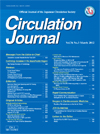Volume 67, Issue 10
Displaying 1-21 of 21 articles from this issue
- |<
- <
- 1
- >
- >|
Special Article
-
Article type: None
Subject area: None
2003Volume 67Issue 10 Pages 805-809
Published: 2003
Released on J-STAGE: September 25, 2003
Download PDF (196K)
Clinical Investigation
-
Article type: None
Subject area: None
2003Volume 67Issue 10 Pages 810-815
Published: 2003
Released on J-STAGE: September 25, 2003
Download PDF (333K) -
Article type: None
Subject area: None
2003Volume 67Issue 10 Pages 816-820
Published: 2003
Released on J-STAGE: September 25, 2003
Download PDF (223K) -
Article type: None
Subject area: None
2003Volume 67Issue 10 Pages 821-825
Published: 2003
Released on J-STAGE: September 25, 2003
Download PDF (341K) -
Article type: None
Subject area: None
2003Volume 67Issue 10 Pages 826-829
Published: 2003
Released on J-STAGE: September 25, 2003
Download PDF (285K) -
Article type: None
Subject area: None
2003Volume 67Issue 10 Pages 830-834
Published: 2003
Released on J-STAGE: September 25, 2003
Download PDF (315K) -
Article type: None
Subject area: None
2003Volume 67Issue 10 Pages 835-838
Published: 2003
Released on J-STAGE: September 25, 2003
Download PDF (58K) -
Article type: None
Subject area: None
2003Volume 67Issue 10 Pages 839-845
Published: 2003
Released on J-STAGE: September 25, 2003
Download PDF (128K) -
Article type: None
Subject area: None
2003Volume 67Issue 10 Pages 846-850
Published: 2003
Released on J-STAGE: September 25, 2003
Download PDF (1356K) -
Article type: None
Subject area: None
2003Volume 67Issue 10 Pages 851-854
Published: 2003
Released on J-STAGE: September 25, 2003
Download PDF (155K) -
Article type: None
Subject area: None
2003Volume 67Issue 10 Pages 855-860
Published: 2003
Released on J-STAGE: September 25, 2003
Download PDF (316K) -
Article type: None
Subject area: None
2003Volume 67Issue 10 Pages 861-865
Published: 2003
Released on J-STAGE: September 25, 2003
Download PDF (136K) -
Article type: None
Subject area: None
2003Volume 67Issue 10 Pages 866-870
Published: 2003
Released on J-STAGE: September 25, 2003
Download PDF (66K) -
Article type: None
Subject area: None
2003Volume 67Issue 10 Pages 871-875
Published: 2003
Released on J-STAGE: September 25, 2003
Download PDF (83K)
Experimental Investigation
-
Article type: None
Subject area: None
2003Volume 67Issue 10 Pages 876-880
Published: 2003
Released on J-STAGE: September 25, 2003
Download PDF (287K) -
Article type: None
Subject area: None
2003Volume 67Issue 10 Pages 881-884
Published: 2003
Released on J-STAGE: September 25, 2003
Download PDF (472K)
Case Report
-
Article type: None
Subject area: None
2003Volume 67Issue 10 Pages 885-888
Published: 2003
Released on J-STAGE: September 25, 2003
Download PDF (391K) -
Article type: None
Subject area: None
2003Volume 67Issue 10 Pages 889-890
Published: 2003
Released on J-STAGE: September 25, 2003
Download PDF (41K) -
Article type: None
Subject area: None
2003Volume 67Issue 10 Pages 891-894
Published: 2003
Released on J-STAGE: September 25, 2003
Download PDF (298K) -
Article type: None
Subject area: None
2003Volume 67Issue 10 Pages 895-897
Published: 2003
Released on J-STAGE: September 25, 2003
Download PDF (512K)
Rapid Communication
-
Article type: None
Subject area: None
2003Volume 67Issue 10 Pages 898-900
Published: 2003
Released on J-STAGE: September 25, 2003
Download PDF (341K)
- |<
- <
- 1
- >
- >|
